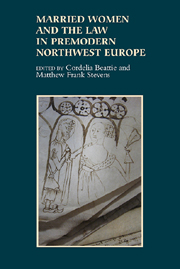Book contents
- Frontmatter
- Contents
- Figures and Tables
- Contributors
- Introduction: Uncovering Married Women
- 1 Inheritance, Property and Marriage in Medieval Norway
- 2 Spousal Disputes, the Marital Property System, and the Law in Later Medieval Sweden
- 3 When Two Worlds Collide: Marriage and the Law in Medieval Ireland
- 4 Married Women, Crime and the Courts in Late Medieval Wales
- 5 Peasant Women, Agency and Status in Mid-Thirteenth- to Late Fourteenth-Century England: Some Reconsiderations
- 6 London's Married Women, Debt Litigation and Coverture in the Court of Common Pleas
- 7 Married Women, Contracts and Coverture in Late Medieval England
- 8 Property, Family and Partnership: Married Women and Legal Capability in Late Medieval Ghent
- 9 ‘For His Interest’? Women, Debt and Coverture in Early Modern Scotland
- 10 The Worth of Married Women in the English Church Courts, c.1550–1730
- 11 Married Women, Work and the Law: Evidence from Early Modern Germany
- Index
6 - London's Married Women, Debt Litigation and Coverture in the Court of Common Pleas
Published online by Cambridge University Press: 05 July 2013
- Frontmatter
- Contents
- Figures and Tables
- Contributors
- Introduction: Uncovering Married Women
- 1 Inheritance, Property and Marriage in Medieval Norway
- 2 Spousal Disputes, the Marital Property System, and the Law in Later Medieval Sweden
- 3 When Two Worlds Collide: Marriage and the Law in Medieval Ireland
- 4 Married Women, Crime and the Courts in Late Medieval Wales
- 5 Peasant Women, Agency and Status in Mid-Thirteenth- to Late Fourteenth-Century England: Some Reconsiderations
- 6 London's Married Women, Debt Litigation and Coverture in the Court of Common Pleas
- 7 Married Women, Contracts and Coverture in Late Medieval England
- 8 Property, Family and Partnership: Married Women and Legal Capability in Late Medieval Ghent
- 9 ‘For His Interest’? Women, Debt and Coverture in Early Modern Scotland
- 10 The Worth of Married Women in the English Church Courts, c.1550–1730
- 11 Married Women, Work and the Law: Evidence from Early Modern Germany
- Index
Summary
Introduction: the Court of Common Pleas and the London Evidence
In the weeks after the feast of St Hilary (13 January) in 1403 a plea brought on a writ of debt, between plaintiffs Margaret le Toller of Smithfield, London, and her husband John le Toller, and defendant Richard Barbour of Wycombe, Buckinghamshire, was heard before the justices of the royal Court of Common Pleas at West-minster. In this case, Margaret and her husband claimed that nearly two decades before, on 8 August 1384, while Margaret was a single woman, an accounting was held between herself and Richard Barbour in the London parish of St Bride Fleet Street before two London tradesmen appointed by Margaret as auditors. Margaret pleaded that this accounting found Barbour to owe her £10 arrears and clear debt concerning diverse monies and receipts, which ‘although often requested’ he had not yet paid, neither ‘to Margaret as a single woman, nor to John le Toller and Margaret since their marriage’. Barbour responded, not denying the alleged accounting nor debt, by pleading that just over three years before, on 6 October 1399, he, John and Margaret had submitted to arbitration before certain men, at Wycombe, concerning all debts and disputes between them from the creation of the world until that day. And further, Barbour pleaded that this arbitration had decided that he ought to pay John and Margaret 18d. to settle all disputes between them, which he duly paid, thereby acquitting himself of all obligations to the couple.
- Type
- Chapter
- Information
- Married Women and the Law in Premodern Northwest Europe , pp. 115 - 132Publisher: Boydell & BrewerPrint publication year: 2013

